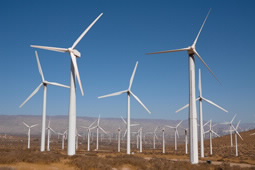FOR IMMEDIATE RELEASE
ACS News Service Weekly PressPac: April 25, 2012
Shift to green energy sources could mean crunch in supply of scarce metals
“Evaluating Rare Earth Element Availability: A Case with Revolutionary Demand from Clean Technologies”
Environmental Science & Technology
A large-scale shift from coal-fired electric power plants and gasoline-fueled cars to wind turbines and electric vehicles could increase demand for two already-scarce metals — available almost exclusively in China — by 600-2,600 percent over the next 25 years, a new study has concluded. Published in the ACS journal Environmental Science & Technology, it points out that production of the two metals has been increasing by only a few percentage points per year.
Randolph E. Kirchain, Ph.D., and colleagues explain that there has been long-standing concern about a secure supply of the so-called rare earth elements, 17 elements adjacent on the periodic table of elements. These metals are used to make airplane components and lasers for medical imaging. Two of the rare earths, dysprosium and neodymium, are critical for current technologies for manufacturing wind turbines that generate electricity and electric vehicles. Those green technologies, Kirchain notes, would be essential in carrying out a proposed stabilization in atmospheric levels of carbon dioxide, the main greenhouse gas, at 450 parts per million. Kirchain’s team analyzed the supply of lanthanum, cerium, praseodymium, neodymium, samarium, europium, gadolinium, terbium, dysprosium and yttrium under various scenarios.
They projected the demand for these 10 rare earth elements through 2035. In one scenario, demand for dysprosium and neodymium could be higher than 2,600 and 700 percent respectively. To meet that need, production of dysprosium would have to grow each year at nearly twice the historic growth rate for rare earth supplies. “Although the RE [rare earth] supply base has demonstrated an impressive ability to expand over recent history, even the RE industry may struggle to keep up with that pace of demand growth,” the authors said. But they also point out that shortfalls in future supply could be mitigated “through materials substitution, improved efficiency, and the increased reuse, recycling, and use of scrap.”
![]()
Contact
Science Inquiries: Michael Woods, Editor, 202-872-6293
General Inquiries: Michael Bernstein, 202-872-6042


